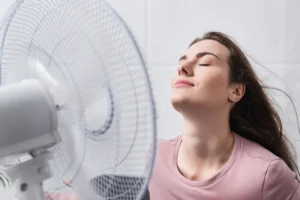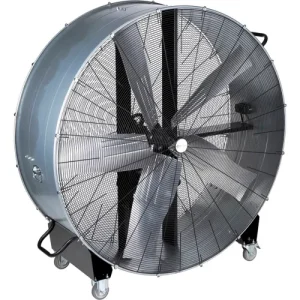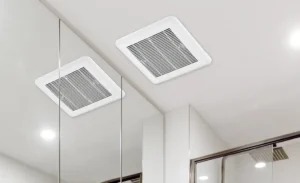The choice between a tower fan and a pedestal fan is a common conundrum faced by many seeking efficient and effective cooling solutions for their spaces.
Both tower and pedestal fans offer distinct advantages and features, making them suitable for different environments and preferences.
This article delves into various aspects such as design, power, noise level, placement, cost, and additional features to aid in making an informed decision.
Design and Aesthetics: Blending with Modern Interiors
The design and aesthetics of a fan are crucial in determining its compatibility with your living or working space.
Fans are not only functional appliances but also elements of interior decor, and their design can significantly influence the overall ambiance of a room.
Tower Fans: Sleek and Modern
- Visual Appeal: Tower fans are known for their sleek, vertical design. Their modern and often minimalist appearance allows them to blend seamlessly into contemporary interiors. This aesthetic appeal is a significant factor for many who prefer appliances that complement their home decor.
- Space-Saving: Due to their slim profile, tower fans are particularly suited for smaller spaces or areas where saving floor space is important. They can be easily placed in corners or alongside furniture without disrupting the room’s layout.
- Variety in Style: Tower fans come in various styles and finishes, ranging from basic models to high-end designs with premium materials. Some feature a futuristic look, with smooth surfaces and digital displays, adding a touch of modernity to any space.
Pedestal Fans: Traditional yet Versatile
- Classic Design: Pedestal fans have a more traditional design, with a visible fan head mounted on an adjustable stand. This classic look has a nostalgic appeal and can blend well in a variety of settings, from residential to commercial spaces.
- Adjustable Features: Despite their conventional design, many pedestal fans offer adjustable heights and head tilts, providing versatility in directing airflow. This functionality can be particularly useful in larger or irregularly shaped rooms.
- Diverse Appearances: While generally more traditional in appearance, pedestal fans also come in a range of designs, from basic to more elaborate styles. Some models are designed with a retro look, adding a unique charm to spaces that favor a vintage aesthetic.
Impact on Room Ambiance
- Complementing Decor: Choosing a fan that complements your interior design can enhance the overall ambiance of a room. Whether it’s a sleek tower fan for a modern living room or a classic pedestal fan for a more traditional setting, the right fan can serve as a functional accessory.
- Attention to Detail: For those who pay attention to the finer details of their home decor, the choice between a tower and a pedestal fan can be significant. It’s not just about the airflow; it’s about how the fan contributes to the visual harmony of the space.
Power and Airflow: Maximizing Efficiency
The efficiency of a fan is significantly determined by its power and airflow capabilities.
Understanding these aspects is crucial for selecting a fan that not only cools effectively but also aligns with the specific needs of your environment.
Tower Fans: Optimized for Smaller Spaces
- Air Movement: Tower fans are designed to provide a moderate level of air movement, characterized by lower CFM (cubic feet per minute) ratings. This makes them more suitable for smaller, residential spaces where gentle air circulation is desired.
- Focused Flow: The airflow from a tower fan is often more directed and localized. This can be advantageous in personal spaces or specific areas within a room, providing targeted cooling without overwhelming the entire space.
- Energy Efficiency: Due to their smaller motors and focused airflow, tower fans can be more energy-efficient for daily use in residential settings. This efficiency is beneficial for those seeking to minimize energy consumption while maintaining a comfortable environment.
Pedestal Fans: High Power for Larger Areas
- Greater Airflow: Pedestal fans are known for their ability to generate a high volume of air movement, making them ideal for larger rooms or commercial spaces. Their powerful motors and larger blades facilitate this capability, providing effective cooling over a wider area.
- Adjustable Settings: Many pedestal fans come with various speed settings, allowing users to customize the intensity of the airflow. This adaptability is essential for environments that require different levels of air circulation throughout the day.
- Versatile Use: The high-power output of pedestal fans makes them suitable for a range of applications beyond just cooling. They can be used for ventilating spaces, aiding in drying processes, or even circulating warm air during colder months.
Comparative Analysis
- Room Size Consideration: The choice between a tower and a pedestal fan should be influenced by the size of the room. In smaller, confined spaces, a tower fan’s directed airflow is more appropriate, whereas, in larger areas, the powerful and extensive reach of a pedestal fan is more effective.
- Airflow Direction: Pedestal fans often offer greater control over airflow direction, with adjustable heads that can be tilted or rotated. This flexibility is less common in tower fans, which typically have a fixed airflow path.
- Efficiency in Usage: In terms of efficiency, tower fans are better suited for continuous, low-power usage in residential settings. Pedestal fans, with their higher power consumption, are more efficient for short-duration, high-intensity use in larger spaces or outdoor environments.
Noise Level: Ensuring Quiet Operation
The noise level of a fan is a critical aspect, especially in environments where tranquility is a priority.
Whether it’s for a peaceful night’s sleep, an undisturbed work environment, or simply a preference for quieter appliances, understanding the noise dynamics of tower and pedestal fans is essential.
Tower Fans: The Quieter Choice
- Engineered for Silence: Tower fans are generally designed to operate quietly. Their internal blade structure and motor design contribute to a lower sound output, making them a preferred choice in noise-sensitive areas such as bedrooms and offices.
- Bladeless Technology: Some tower fans utilize bladeless technology, which further reduces noise. This design minimizes the sound of air chopping, which is a common noise source in traditional fans. The result is a smoother, quieter airflow.
- Speed Settings and Noise: Lower speed settings on tower fans typically produce very little noise, ideal for nighttime use or quiet environments. Even at higher speeds, the noise level usually remains relatively low compared to other fan types.
Pedestal Fans: Balancing Power and Noise
- Variability in Noise Levels: Pedestal fans, given their larger size and higher power, can produce more noise. However, this largely depends on the specific model and its blade design. Modern pedestal fans are increasingly designed to minimize noise, even at higher speeds.
- Customizable Settings for Noise Reduction: Many pedestal fans come with multiple speed settings, allowing users to choose a lower speed for quieter operation. Some models are specifically designed as ‘quiet’ or ‘silent’ fans, catering to environments where noise reduction is crucial.
- Context of Use: In larger spaces or outdoor settings where pedestal fans are commonly used, the ambient noise is often higher, making the fan’s noise less noticeable. In these scenarios, the powerful airflow of a pedestal fan is a trade-off for its higher noise level.
Comparing Fan Types for Noise Sensitivity
- Room Usage Consideration: The choice between a tower and a pedestal fan should consider the intended room’s noise sensitivity. For bedrooms, libraries, or quiet office spaces, a tower fan’s low noise profile is advantageous. For larger areas or less noise-sensitive environments, a pedestal fan’s noise level might be acceptable.
- Noise vs. Airflow Needs: It’s important to balance the need for quiet operation with the desired airflow. In situations where powerful air circulation is a priority, a pedestal fan may be the more suitable choice, despite its potentially higher noise level.
- Technological Advances: Both tower and pedestal fans have benefited from advances in fan technology, with many models focusing on reducing operational noise. It’s advisable to check the specific noise ratings and user reviews when selecting a fan.
Placement and Mobility: Versatility in Usage
The versatility in the placement and mobility of a fan is a key factor in its practicality and convenience.
Both tower and pedestal fans offer unique features in this regard, catering to different spatial and usage requirements.
Tower Fans: Compact and Convenient
- Space Efficiency: Tower fans, with their slender and vertical design, are incredibly space-efficient. This makes them ideal for smaller rooms or cramped spaces where saving floor space is a priority.
- Ease of Movement: Most tower fans are lightweight and often come with a carrying handle, making them easy to move from room to room. Their compactness allows for effortless repositioning as needed.
- Stylish Placement: Due to their stylish designs, tower fans can be placed as a part of the room’s decor. They can be easily integrated into the living area, bedroom, or office without looking out of place.
Pedestal Fans: Adjustable and Adaptable
- Height and Direction Adjustment: Pedestal fans stand out for their adjustable height and the ability to tilt or rotate the fan head. This flexibility allows for targeted airflow, making them versatile for use in various room configurations.
- Stability and Footprint: The broader base of pedestal fans provides stability, but also requires more floor space. This aspect needs consideration in tight spaces but is advantageous for steady operation in high-traffic areas or outdoor settings.
- Portability Features: Some pedestal fans come with features that enhance their portability, such as wheeled bases, making them easier to move around, especially in larger spaces or commercial environments.
Comparative Aspects of Placement and Mobility
- Room Size and Layout: The choice between a tower and pedestal fan should consider the room’s size and layout. Tower fans are more suitable for compact areas or where a discrete presence is desired. Pedestal fans are better for larger spaces where their airflow range and stability are beneficial.
- Flexibility in Use: While tower fans offer the advantage of being easily movable and space-saving, pedestal fans provide more options in terms of airflow direction and height adjustment, catering to a wider range of cooling needs.
- Outdoor and Commercial Use: For outdoor areas or commercial settings, pedestal fans are often more practical due to their robust construction and adaptable placement options. Tower fans, being more suited to indoor environments, may not offer the same level of adaptability in such settings.
Cost Considerations: Evaluating Affordability
When selecting a fan, cost is often a significant factor.
The affordability of a fan not only encompasses its initial purchase price but also its operational costs and long-term value.
Both tower and pedestal fans come with different price points and features that can influence their overall cost-effectiveness.
Tower Fans: A Spectrum of Prices
- Initial Cost: Tower fans vary in price, with basic models being quite affordable. However, as features and design sophistication increase, so does the price. High-end tower fans with advanced features like air purification and smart home integration can be considerably more expensive.
- Operational Efficiency: Many tower fans are designed to be energy-efficient, which can lead to lower electricity costs over time. This is particularly beneficial for users who plan to use their fan frequently or for prolonged periods.
- Feature-Related Costs: The more features a tower fan has (like multiple speed settings, remote control, and special functions), the higher the price. These features, while contributing to convenience and functionality, need to be evaluated against the user’s actual needs and budget.
Pedestal Fans: Affordability and Functionality
- Range of Prices: Pedestal fans generally offer more affordable options, especially for basic models. They provide functional cooling solutions without a hefty price tag, making them accessible for a broader range of budgets.
- Durability and Longevity: Many pedestal fans are built for durability, which can translate to better long-term value. Investing in a slightly more expensive model can often mean a longer lifespan and fewer replacements over time.
- Commercial Grade Options: Higher-end pedestal fans, particularly those designed for commercial or industrial use, can be more expensive. These models are equipped with features suited for rigorous use, such as higher airflow capacity and rugged construction, justifying their higher cost.
Balancing Cost with Needs
- Understanding Usage Requirements: The choice between a tower and a pedestal fan should be influenced by how and where the fan will be used. For occasional use in a small space, a basic tower fan might suffice. In contrast, for more extensive use or in larger areas, investing in a durable pedestal fan could be more cost-effective.
- Considering Long-Term Savings: While the upfront cost is important, considering the fan’s energy consumption and maintenance needs can provide a clearer picture of its long-term affordability.
- Quality vs. Price: It’s crucial to balance the quality and features of a fan with its price. A very cheap fan might save money initially but could have higher operational costs or a shorter lifespan, leading to more expenses in the long run.
Additional Features: Enhancing User Experience
When choosing between tower and pedestal fans, additional features can significantly enhance user experience and convenience.
These features, ranging from basic to technologically advanced, cater to various preferences and needs, adding value beyond the basic function of air circulation.
Advanced Features in Tower Fans
- Smart Technology Integration: Many modern tower fans are equipped with smart technology, allowing for integration with home automation systems. This includes features like Wi-Fi connectivity, compatibility with voice assistants, and app-controlled settings, providing convenience and remote operability.
- Air Quality Improvement: Some tower fans go beyond simple air circulation and include air purification or ionization features. This can be particularly beneficial in urban settings or for individuals with allergies, as these fans help in reducing airborne pollutants.
- Customizable Settings: Features like variable speed settings, oscillation control, and programmable timers allow users to customize the fan’s operation to their specific needs, whether it’s gentle air movement at night or intensive cooling during hot days.
- Design Innovations: Bladeless designs, sleek LED displays, and aesthetic finishes make tower fans not only functional appliances but also stylish additions to modern interiors.
Versatile Features in Pedestal Fans
- Adjustable Height and Oscillation: The ability to adjust the height and angle of the fan head in pedestal fans offers greater control over airflow direction, making them versatile for different room sizes and cooling requirements.
- High-Performance Options: For more demanding environments, there are pedestal fans with high airflow capacity, industrial-grade motors, and robust construction, suitable for commercial or outdoor use.
- Safety Features: Features like sturdy bases for stability and basket-style safety guards make pedestal fans safe and reliable, especially in households with children or pets.
- Customization Options: Some pedestal fans offer interchangeable fan blades or decorative elements, allowing users to personalize the fan’s appearance to match their decor or preferences.
Comparing Features for Optimal Choice
- Environment Suitability: The choice of features should be aligned with the environment where the fan will be used. Smart and aesthetic features may be more desirable in home settings, while durability and high-performance features are crucial for commercial or industrial use.
- Cost vs. Benefit Analysis: While additional features can enhance user experience, they also impact the cost. It’s important to weigh the benefits of these features against their cost to determine if they offer value for money.
- Ease of Maintenance: Consideration should be given to the ease of maintenance and cleaning. Features like removable grills or bladeless designs can simplify the cleaning process, ensuring long-term efficiency and hygiene.
FAQs
Is it bad to leave a tower fan on all night?
No, it’s generally not bad to leave a tower fan on all night.
Many people find it comfortable for sleeping, especially in warm weather.
However, ensure the fan is in good working condition and placed stably to prevent any safety hazards.
Also, consider using a fan with a timer or low noise level for a more comfortable sleep environment.
Do these fans consume a lot of electricity compared to other appliances?
Fans generally consume less electricity compared to many other household appliances, especially air conditioners.
Energy-efficient models of both tower and pedestal fans are available, which can further reduce power consumption.
How often should I clean my tower or pedestal fan, and is it easy to do?
Regular cleaning, ideally every few weeks during usage, is recommended to ensure optimal performance.
Tower fans may require disassembly for thorough cleaning, while pedestal fans often have removable grills for easier access to blades.
Are there any health benefits to using tower or pedestal fans?
Both types of fans can improve air circulation in a room, which can be beneficial for health by reducing stuffiness and distributing fresh air.
However, it’s important to ensure that the fan doesn’t blow directly on you for prolonged periods, as this can cause dry eyes or skin irritation.
Where is the best place to put a pedestal fan?
The ideal placement for a pedestal fan is near windows or doors, as these are common entry points for cooler air from outside.
Positioning the fan in this manner helps in creating a pleasant breeze that circulates quickly throughout the room, enhancing overall air circulation and cooling efficiency.
Additionally, placing your pedestal fan across from the larger part of the room ensures the best distribution of air, contributing to more effective cooling.
This strategic placement can also help in reducing energy bills over time by maximizing the fan’s cooling potential.




